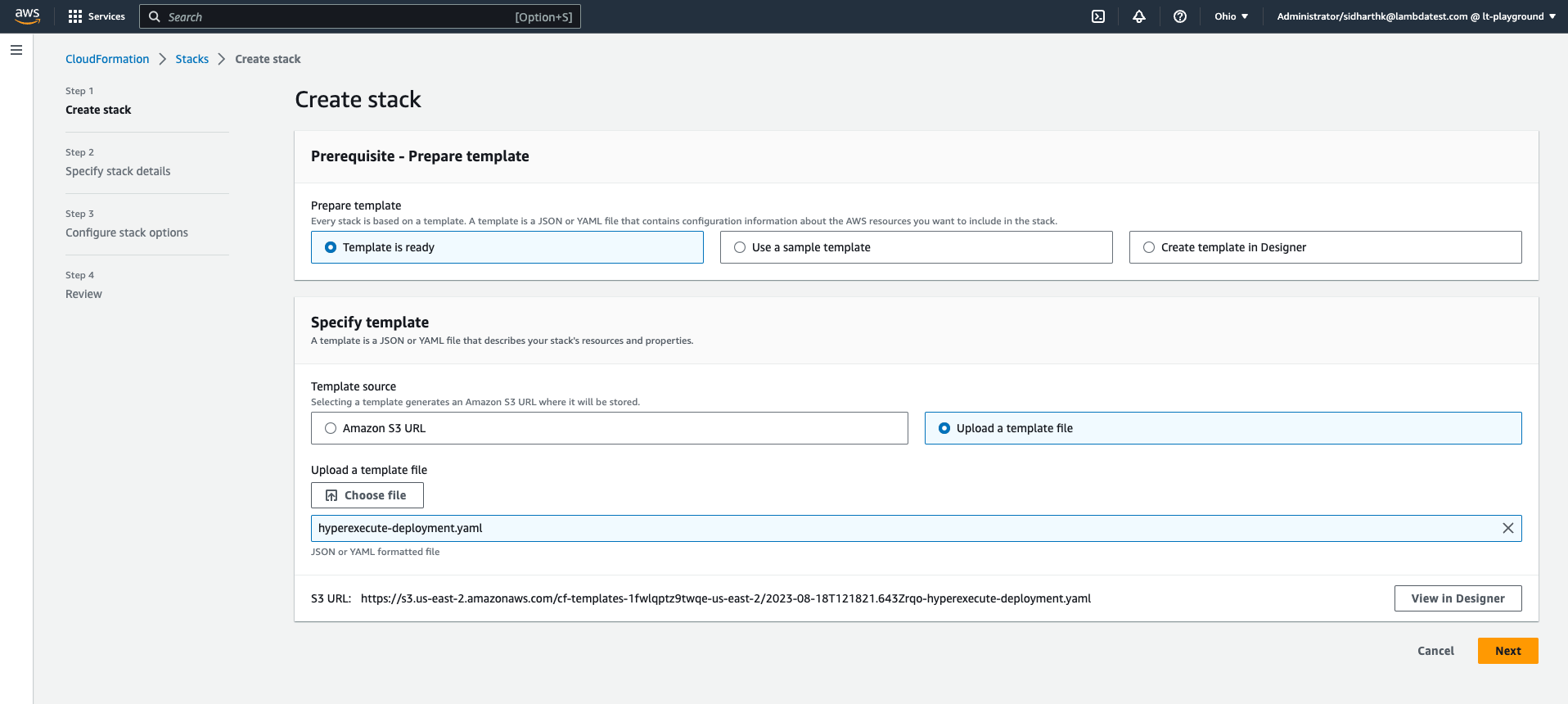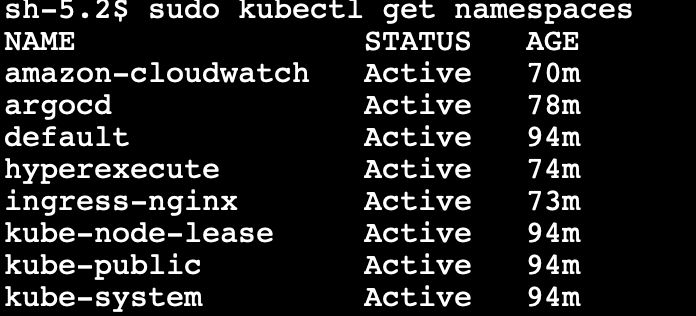How to setup HyperExecute Private Cloud with AWS
Prerequisites
Before deploying the CloudFormation template for HyperExecute through the AWS Marketplace, ensure that the following prerequisites are met:
-
Region with min 3 availability zones: Make sure you are running the CloudFormation in a region that supports a minimum of 3 availability zones. The currently supported regions are
us-east-1,us-east-2,us-west-2,eu-central-1,ap-south-1, andap-southeast-2. -
Elastic IPs (EIPs): HyperExecute requires 3 Elastic IPs for each availability zone (AZ). Ensure that you have sufficient quota for EIPs in your AWS account. You can refer to the EIP Limits to check your quota.
-
EC2 quota limits: The CloudFormation template will create EC2 instances as part of a Managed NodeGroup, with a minimum requirement of 5 nodes, and an Auto Scaling Group with a maximum size based on your concurrency license. Make sure to increase your EC2 quota limits accordingly.
Steps to Deploy
To deploy the CloudFormation template on AWS, follow these steps:
Step 1: Download the CloudFormation template named hyperexecute_deployment.yaml from the AWS Marketplace.
Step 2: Navigate to the AWS CloudFormation console and choose Create Stack .
Step 3: On the Create Stack page, select the option Template is ready and click on the Upload a template file" option.
Step 4: Browse for the main template file hyperexecute_deployment.yaml and click Next.

Step 5: On the Specify Stack details page, provide a name for the stack (deployment) and provide the necessary configuration details. Refer to the configuration parameters details sections for guidance.
Step 6: On the next page, under the Configure stack option, change the Stack failure options to preserve the successfully provisioned resources. This helps in preserving the created resources and troubleshooting issues in case of a stack failure.
Step 7: Click Next to review all the details, and then initiate the launch to deploy the HyperExecute CloudFormation stack.

By following these steps, you can deploy the HyperExecute CloudFormation template from the AWS Marketplace and set up the required infrastructure for your testing needs.

Configuration Parameters
Please provide the following configuration details based on the type of installation you want to perform:
User Details
In the User Details section, provide the following details as required:
| Parameter | Description |
|---|---|
| EmailID | Your valid email ID to set up a LambdaTest account. If you already have a LambdaTest Account, you can specify that email ID. |
| ManagedAppName | Provide a unique ManagedAppName to be used for the application environment in the cluster. It must be between 5 to 20 characters long and can only contain lowercase letters. |
VPC Configuration
In the VPC Configuration, provide the following details as required:
| Parameter | Description |
|---|---|
| VpcCidr | The VPC CIDR block. Must be a valid IP CIDR range of the form x.x.x.x/x. Default Value: 10.10.0.0/16 |
| AvailabilityZones | List of Availability Zones to use for the subnets in the VPC. You must select three Availability Zones in the specified order. |
EKS Configuration
In the EKS Configuration, provide the following details as required:
| Parameter | Description |
|---|---|
| ManagedNodeGroupInstanceType | Specify the instance types for a node group. Default Value: m5.xlarge |
| SpotNodes | Enable Spot Nodes for the EKS cluster. Default Value: No |
| IngressLBType | Type of Ingress Load Balancer to create for the EKS Cluster. Private Load Balancer will only be accessible within the VPC. |
VMS Autoscaling Group
In the VMS Autoscaling Group, provide the following details as required:
| Parameter | Description |
|---|---|
| VMInstanceType | Specify the instance types for an EC2 Auto Scaling Group. |
| SpotVMs | Enable Spot EC2 instances for the Auto Scaling Group. Default Value: No |
| KeyPairName | Name of an existing EC2 key pair for SSH access to the instances in the Auto Scaling Group. |
Other Configuration
In the Other Configuration, provide the following details as required:
| Parameter | Description |
|---|---|
| RedisClusterNodeType | The ElasticCache node type. Default value: cache.t3.small |
| DebugMode | Enable debug mode for your environment to run preview images in your EKS cluster. Default Value: No |
| WindowsJumpHost | Enable a Windows jump host for accessing your Windows machines in your Auto Scaling Group. Default Value: No |
Accessing HyperExecute after deployment
Once the CloudFormation template is successfully deployed, you can access HyperExecute and perform the following steps:
Step 1: Login into the EC2 instance named "HyperExecute-Admin-Bastion" using either SSM (Session Manager) or the SSH key provided in the Configuration Parameters. Note that SSH access is allowed by default within the VPC.
Step 2: Log in to the AWS environment and access the Kubernetes cluster by running the following command on AWS CLI:
aws eks --region <region_name> update-kubeconfig --name <cluster_name>
Replace <region_name> with the appropriate region and <cluster_name> with the name of your cluster.
Step 3: Execute the command:
kubectl get namespaces
This command will provide a list of namespaces created.

Step 4: Execute the command:
kubectl get po -n hyperexecute
This command will provide a list of pods created under the hyperexecute namespace.

Step 5: Access the Private Cloud deployment using the provided link.
Step 6: If the emailID you used to setup this deployment is not an existing user on LambdaTest then check your Email, there should be a email titled Create Password - LambdaTest, generate a new password using the link provided in the email.
Step 7: Login using your email and password and run jobs using the HyperExecute CLI. For further details about HyperExecute, refer to the documentation.
Cleanup the Environment
If you wish to clean up the resources created during the deployment, follow these steps:
Step 1 : Ensure that the objects inside the S3 bucket created by the CloudFormation template with the name ${AWS::StackName}-${AWS::AccountId}-hyperexecute-bucket are deleted before the bucket can be deleted.
Step 2 : Delete the images in the ECR (Elastic Container Registry) repository with the name ${ManagedAppName}-hyperexecute-private-cloud before deleting the repository.
Step 3 : Delete the root stack from CloudFormation. This will delete all the nested stacks and their resources.
Step 4 : CloudWatch log groups are not deleted by default. Manually navigate to CloudWatch and delete the log groups starting with the following regex patterns:
/aws/lambda/*-ClusterCreatorFunction-*/aws/lambda/*-ClusterOIDCURLFunction-*/aws/lambda/*-HyePrivateCloudFunction-*/aws/containerinsights/${ManagedAppName}-hyperexecute-eks-cluster/*
Step 5 : If you have used the secrets feature in HyperExecute, the secrets with the regex pattern hyperexecute-secrets-* will not be deleted. Manually navigate to AWS Secret Manager and delete the secrets.
Make sure to follow these cleanup steps to remove the resources associated with the HyperExecute deployment.
